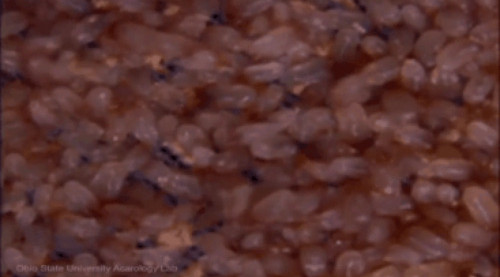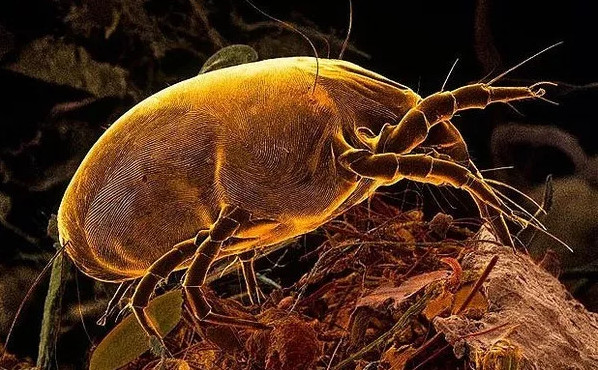We are sleeping with these terrifying creatures
Scientists at Ohio State University's Acarology Laboratory recently published a video that captures the most realistic picture of the world of organisms growing on your bedspread.
Are we sleeping with millions of dust mites every day?
Specifically, viewers can't help but shudder when millions of dust mites are writhing on your bed under a microscope. You have good, on your bed can hold up to 100,000 - 10 million dust mites with super small size. This is a creature that exists by eating human dead skin cells.
At first glance, they seem to be useful species but in reality they are not. Dust mites have a very unhygienic habit, that is to go "universe" up to 20 times a day to bed. Therefore, your body will be at risk when inhaling their stool every day.

Do you see yellow spots, that is the "delicate waste" of the dust mite.
According to scientific experts, dust mite (scientific name is Dermatophagoides pteronyssinus ) is present and widely distributed all over the world. They are very small in size, about 0.3mm, reside in many household items such as beds, pillows, blankets, curtains, mats, carpets . In those places, they often eat Organic debris like small skin scales, dead cells, dandruff flakes from the ends . and proliferate.

Dust mites are very small in size - about 0.3mm.
Dr. Lisa Ackerley, a hygiene expert, said: "The human skin removes 30,000 to 40,000 dead cells / minute, and the environment is hot and humid, the bed will be the paradise of dust mites. This can be up to 10 million. "
She shared that dust mites often lay eggs, hatch into nymphs (nymphs) and mature through 2-3 times molting, so in 2 years, 1 % of the weight of the pillow you are lying is made up of mites dust and their droppings.

Although dust mites can be harmless, their waste is the reason many people are prone to asthma, allergies, and rashes. Because the waste of dust mites is very small and lighter than dust, they fly in the air so people can easily breathe into the lungs, causing respiratory disease.
Besides, dust mites also cause allergies in the eyes, nose, eczema, erythema, blisters, rashes . on the cheeks, elbows, elbows or heavier than causing hives. , itchy, floating water balloon. For long periods of time, patients may be infected by scratching .
Therefore, experts recommend that you change your laundry, pillows, and blankets regularly to reduce the food of mites - thereby reducing the number of mites. Or every week should be dried blanket, gas, pillow to the sun - sunshine containing ultraviolet rays will somewhat destroy dust mites. Besides, at the corners of the house, carpets also need to be cleaned.
- 10 most terrifying sea creatures
- Discover the most terrifying monster of the planet under the ocean
- Strange creatures like aliens crawling on the ceiling, terrifying people
- Why is it good to sleep on one side?
- 13 most terrifying and mysterious creatures in the world
- Types of 'demons, gods' sleep in folk tales
- Explaining the cause of the terrifying giant creatures under the sea
- Guess the puppy's personality through the 6 most popular sleeping postures
- Research: Sleeping naked makes you happier
- New discovery about the effectiveness of sleeping pills
- Discover the nest of bacteria sleeping with your bed
- Not having a good sleep? Try to see if there is 1 in 5 reasons!
 Why do potatoes have eyes?
Why do potatoes have eyes? 'Tragedy' the world's largest carnivorous life: Death becomes ... public toilet
'Tragedy' the world's largest carnivorous life: Death becomes ... public toilet Tomatoes were once considered 'poisonous' for 200 years
Tomatoes were once considered 'poisonous' for 200 years Detecting microscopic parasites on human face
Detecting microscopic parasites on human face Saharan dust is important for ecological protection and climate change
Saharan dust is important for ecological protection and climate change  Strange weather is happening in European countries
Strange weather is happening in European countries  Electrodynamic shield technology to deal with lunar dust
Electrodynamic shield technology to deal with lunar dust  How dangerous is red dust to health?
How dangerous is red dust to health?  Cockroaches that eat lunar dust from the Apollo 11 mission are being auctioned
Cockroaches that eat lunar dust from the Apollo 11 mission are being auctioned  Biocrusts biocrust helps reduce global dust emissions by 60%
Biocrusts biocrust helps reduce global dust emissions by 60% 